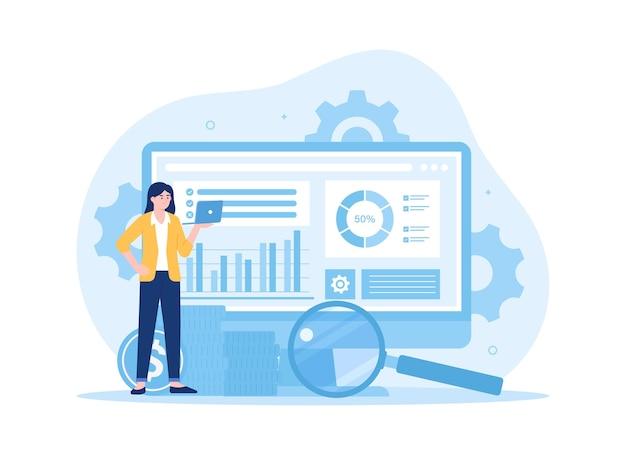Top 7 Data Observability Tools in 2024 to Ensure Data Integrity and Performance

Audio : Listen to This Blog.
Picture this: You’re a data engineer, and a frantic email rudely interrupts your well-deserved coffee break. The data pipeline has broken—again. The dashboards are showing gibberish, and the boss needs answers. It was yesterday. This is a classic case of data downtime, where partial, erroneous, or missing data leads to broken data pipelines and erroneous dashboards. If only you had a superpower to foresee and prevent these disasters!

Enter data observability tools that ensure your data remains as pristine and performant as your favorite playlist. In 2024, the world of data observability tools is buzzing with innovation, and I’ve handpicked the top seven you need to know about. Let’s dive in, shall we?
1. Datadog
First on our list is Datadog, one of the leading data observability platforms renowned for its observability and performance monitoring capabilities. Datadog provides a unified observability platform that combines metrics, traces, logs, and more. As one of the best data observability tools, Datadog helps you monitor and troubleshoot data in real-time.
Key Features:
Metric Collection: Datadog collects and stores metrics from over 400 different technologies
Datadog excels in the metric collection by offering seamless integration with over 400 technologies, ranging from popular cloud services to container orchestration platforms and databases. This extensive compatibility ensures that whether you’re using AWS, Kubernetes, MySQL, or another technology, Datadog can gather detailed metrics across your entire stack. These metrics provide critical insights into system performance, allowing you to monitor CPU usage, memory consumption, network traffic, and more.
Log Management: Centralize and analyze logs to identify patterns and anomalies

Datadog’s log management capabilities allow organizations to centralize and systematically analyze log data from various applications and infrastructure components. Logs are essential for tracking system behavior, debugging issues, and ensuring compliance. With Datadog, you can ingest and process vast volumes of log data in real time, making it easier to identify patterns and anomalies that might indicate underlying problems. The platform supports advanced querying and filtering, helping users pinpoint specific events or trends within their logs.
Tracing: Perform end-to-end tracing and visualize dependencies
End-to-end tracing in Datadog allows you to visualize and understand the flow of requests through your entire system, from front-end services to back-end databases. Datadog provides a detailed map of how individual requests propagate through various microservices and dependencies by capturing traces and spans. This tracing capability is crucial for identifying latency issues, bottlenecks, and errors impacting user experience.
AI-driven Alerts: Utilize machine learning to detect anomalies and predict potential issues

Datadog leverages advanced machine learning algorithms to power its AI-driven alerting system, which detects anomalies and predicts potential issues before they escalate. Traditional threshold-based alerts often fall short in complex, dynamic environments where normal behavior can vary significantly. Datadog’s AI-driven alerts overcome this limitation by learning baseline behavior patterns from historical data and continuously adapting to changes. When deviations from these patterns occur, the system generates alerts, flagging potential problems such as performance degradation, resource exhaustion, or unusual traffic spikes.
Why Datadog?
Datadog stands out with its extensive integrations and user-friendly interface. Whether you’re overseeing cloud infrastructure, applications, or databases, Datadog provides a comprehensive view of your data’s health and performance.
2. Monte Carlo
Next is Monte Carlo, a dedicated data observability solution designed to ensure data reliability across your pipeline. With Monte Carlo, data engineering teams can automatically monitor and alert on data quality issues.
Key Features:
Automated Monitoring: Continuously monitor your data pipelines without manual intervention

Automated monitoring is a game-changer for data engineers, eliminating the need for constant manual oversight of data pipelines. Tools like Monte Carlo specialize in this by offering comprehensive, real-time monitoring that continually checks the health and performance of your entire data ecosystem. This automatic surveillance detects issues such as data delays, schema changes, and pipeline failures as they happen, allowing for immediate response and mitigation.
Root Cause Analysis: Quickly identify and resolve data issues at their source
Root cause analysis (RCA) is an essential feature in modern data observability tools that enables swift identification and resolution of data issues at their origin. When a problem is detected—data corruption, missing data, or performance lags—tools like Monte Carlo quickly trace the issue back through the data pipeline to pinpoint its exact source. By providing detailed insights into the data lineage and transformations, these tools allow engineers to understand the context and dependencies associated with the problematic data.
Data Lineage: Track data flows and dependencies across systems
Data lineage features offer a transparent view of data’s journey through various systems, applications, and transformations, providing a comprehensive map of how data moves within an organization. Tools like Monte Carlo excel in visualizing data lineage, enabling users to track data flows from origin to consumption. This visualization helps understand the relationships and dependencies between different datasets and systems, which is crucial for impact analysis, compliance, and debugging.
Anomaly Detection: Detect anomalies using advanced machine learning algorithms

Anomaly detection is a critical capability in data observability tools that leverages advanced machine learning algorithms to identify unexpected patterns or outliers in data. Tools like Monte Carlo use sophisticated models to continuously analyze data streams and detect deviations from established norms, which can indicate potential issues such as fraud, data breaches, or system malfunctions. These algorithms adapt over time, improving their accuracy and reducing false positives. The system generates alerts when an anomaly is detected, enabling prompt investigation and remediation.
Why Monte Carlo?
Monte Carlo is exceptional for its automated monitoring and detailed lineage capabilities. It’s like having a detective on your team always looking for clues that could lead to data disasters.
3. Splunk
Splunk, the juggernaut in log management and analysis, has expanded its capabilities to include full-stack observability, helping manage and monitor complex data systems. Splunk’s data observability tools help you gain insights into the performance and reliability of your data-driven applications.
Key Features:
Log Analysis: Collect and analyze log data from various sources

Log analysis is pivotal for maintaining the health and performance of any data system, and tools like Splunk have set the standard for this functionality. By aggregating and centralizing log data from a myriad of sources—such as servers, databases, applications, and network devices—these tools provide a unified platform for monitoring and troubleshooting. With robust querying and filtering capabilities, log analysis tools allow users to sift through vast amounts of data to identify patterns, trends, and anomalies that could indicate underlying issues.
Real-Time Monitoring: Monitor data in real time to detect performance issues

Real-time monitoring is an indispensable feature for modern data observability tools like Splunk and Datadog, enabling teams to watch their data environments constantly. By providing immediate insights into the state of your systems, real-time monitoring allows for detecting performance issues as they occur rather than after the fact. This instant visibility is crucial for maintaining service levels and ensuring a positive user experience.
Custom Dashboards: Create customized dashboards to visualize metrics and KPIs
Custom dashboards are a powerful feature offered by data observability tools like New Relic and Grafana, allowing users to tailor visualizations to their needs. These dashboards can display various metrics and key performance indicators (KPIs), providing at-a-glance insights into system performance, operational health, and business outcomes. Users can combine data from different sources into a single view, enabling comprehensive monitoring and analysis. Custom dashboards can include various visualizations such as graphs, charts, heatmaps, and tables, each designed to highlight different aspects of the data.
Predictive Analytics: Use machine learning to predict potential system failures
Predictive analytics is a cutting-edge capability in data observability tools that leverages machine learning to anticipate potential system failures before they occur. Tools like Splunk and Datadog use historical data to train predictive models to identify patterns and trends indicative of future issues. By analyzing variables such as CPU and memory usage, disk I/O, network latency, and error rates, these models can forecast when a component will likely fail, or performance may degrade.
Why Splunk?
Splunk’s strength lies in its robust log analysis and real-time monitoring. It’s like having a crystal ball that lets you see what’s happening now and what might happen next.
4. Bigeye
Bigeye is another specialized data observability tool that prevents poor data quality. It provides comprehensive monitoring and validation across your data pipelines, ensuring that your data remains accurate and reliable.
Key Features:
Data Quality Monitoring: Monitor data quality across datasets and pipelines
Data quality monitoring is essential for ensuring the information driving business decisions is accurate, complete, and reliable. Tools like Bigeye are specifically designed to monitor data quality across datasets and pipelines continuously. They assess vital dimensions such as completeness, consistency, accuracy, and timeliness, flagging deviations from predefined standards. By providing automated alerts and detailed reports on data quality issues, these tools help data teams quickly identify and rectify problems.
Anomaly Detection: Detect and alert on anomalies in your data flows
Anomaly detection is a critical feature in data observability tools like Bigeye, enabling the identification of unusual patterns or outliers that could signal potential problems within data flows. Leveraging advanced machine learning algorithms, these tools continuously analyze data streams to detect deviations from expected behavior. An automatic alert is generated when an anomaly is detected—such as a sudden spike in data volume, unexpected changes in data distribution, or unusual correlations.
Custom Metrics: Define and track custom metrics relevant to your business
Custom metrics are a powerful feature offered by data observability tools like Bigeye, allowing organizations to define and track metrics relevant to their unique business needs. These metrics can include anything from data freshness and row counts to specific validation rules that align with business logic. Custom metrics can be visualized in dashboards, included in reports, and used to trigger alerts, making monitoring key performance indicators (KPIs) easier and ensuring data pipelines function optimally. Ultimately, defining and tracking custom metrics enhances the precision and relevance of data monitoring efforts.
Automated Testing: Run automated tests to validate data integrity
Automated testing is a cornerstone of modern data observability tools designed to validate data integrity without manual intervention. Tools like Bigeye allow data teams to set up automated tests that run continuously or on a scheduled basis, ensuring that data remains accurate, consistent, and complete as it moves through pipelines. These tests can include various checks, such as schema validation, data type verification, null value detection, and business rule enforcement.
Why Bigeye?
Bigeye’s focus on data quality makes it an essential tool for data engineers and analysts. It’s like having a meticulous librarian who ensures every book (read: data point) is precisely where it should be.
5. New Relic
New Relic is a well-established name in application performance monitoring and has made significant strides in data observability. New Relic One platform offers everything you need to monitor, diagnose, and optimize your data environments.
Key Features:
Full-Stack Observability: Monitor every aspect of your stack, from infrastructure to applications

Full-stack observability provides a comprehensive view of every layer of your technology stack, from the underlying infrastructure to the applications running on top of it. Tools like New Relic offer this holistic approach, allowing you to monitor servers, networks, containers, databases, application performance, user experience, and more—all from a single platform. By aggregating data across all these components, full-stack observability enables you to detect and diagnose issues more effectively, understand dependencies, and optimize performance end-to-end.
Custom Dashboards: Build dashboards tailored to your specific needs
Custom dashboards are a standout feature in data observability tools, allowing you to build tailored visualizations that meet your unique monitoring and reporting requirements. Platforms like New Relic and Grafana allow combining different types of data, such as metrics, logs, traces, and events, into cohesive, actionable views. You can create dashboards that focus on specific aspects of your systems, such as resource utilization, application performance, error rates, or business KPIs.
AI-Powered Insights: Use AI to gain actionable insights from your data
AI-powered insights transform raw data into meaningful, actionable intelligence by leveraging advanced machine learning algorithms. Observability tools like New Relic use AI to analyze vast amounts of data, identify patterns, and detect anomalies that traditional monitoring approaches might miss. These insights can predict potential issues, such as resource constraints or performance bottlenecks, before impacting your users.
Distributed Tracing: Trace requests through complex and distributed systems
Distributed tracing is a crucial feature for understanding and managing the performance of modern applications that rely on microservices architectures. New Relic and other observability tools offer distributed tracing capabilities that allow you to follow a request’s journey through various services, databases, caches, and external APIs involved in processing it.
Why New Relic?
New Relic shines with its robust set of features and intuitive dashboards. If Data were a rock band, New Relic would be the all-knowing manager, keeping every member in perfect harmony.
6. Grafana Labs
Grafana Labs, known for its open-source visualization tool Grafana, offers a comprehensive observability stack. Grafana Labs provides detailed visualizations of your data assets, enhancing data observability and reliability. Grafana’s data observability tools provide deep insights into your data infrastructure, allowing for effective monitoring and troubleshooting.
Key Features:
Visualization: Create detailed and interactive visualizations of your data
Visualization is a cornerstone feature of data observability tools like Grafana, enabling users to transform raw data into detailed and interactive visual representations. These visualizations come in various forms, such as line charts, bar graphs, heatmaps, and more, each designed to showcase different aspects of your data. Interactive capabilities allow users to zoom in on specific time frames, filter by various dimensions, and drill down into finer details for deeper analysis.
Visualization: Create detailed and interactive visualizations of your data
Visualization is a cornerstone feature of data observability tools like Grafana, enabling users to transform raw data into detailed and interactive visual representations. These visualizations come in various forms, such as line charts, bar graphs, heatmaps, and more, each designed to showcase different aspects of your data. Interactive capabilities allow users to zoom in on specific time frames, filter by various dimensions, and drill down into finer details for deeper analysis.
Alerting: Set up alerts based on customizable thresholds and conditions
Alerting is a vital feature in data observability tools that ensures teams are immediately notified when specified conditions are met, allowing for prompt action before minor issues escalate into major problems. Tools like Grafana and New Relic offer highly customizable alerting mechanisms, enabling users to define thresholds and conditions tailored to their unique operational requirements. For instance, you might trigger an alert if CPU usage exceeds 80% or if a specific API response time surpasses a predefined limit.
Integrations: Integrate with numerous data sources and third-party services
Integration capabilities are essential for effective data observability, enabling tools to collect and correlate data from various sources and third-party services. Platforms like Grafana excel by offering seamless integration with numerous data sources, including databases, cloud services, IoT devices, and application monitoring tools. This broad compatibility ensures you can pull all relevant data into a unified observability platform, providing a comprehensive view of your infrastructure and applications.
Panel Plugins: Extend functionality with a wide range of plugins
Panel plugins are a powerful feature in data observability tools like Grafana that allows users to extend the functionality of their dashboards beyond the default capabilities. These plugins can add specialized visualizations, advanced analyses, and custom interactivity options to your dashboards, accommodating specific needs and preferences. For example, you might use a plugin to display geographical data on a map, visualize statistical distributions, or integrate with external APIs for real-time data feeds.
Why Grafana Labs?
Grafana’s flexibility and extensibility make it a favorite among data professionals. It’s like having a master artist who can perfectly picture your data landscape.
7. Prometheus
Prometheus is an open-source monitoring and alerting toolkit widely used for its powerful querying language and flexible alerting system. It’s a cornerstone of many organizations’ data observability toolset.
Key Features:
Time-Series Database: Store and query time-series data efficiently
A time-series database is fundamental for storing and querying data indexed by time, making it exceptionally suited for applications requiring tracking changes over intervals. Tools like Prometheus are specifically designed to handle time-series data efficiently, allowing you to store vast amounts of metrics with high granularity. These databases are optimized for rapid writes and real-time querying, ensuring that performance remains robust even as data scales.
Flexible Query Language: Use PromQL to query and aggregate data
PromQL, Prometheus’s query language, offers a flexible and powerful means to query and aggregate time-series data. Designed specifically for working with metrics, PromQL allows you to efficiently perform complex calculations, create aggregations, and derive insights from your data. Whether you need to calculate averages, sum values across multiple dimensions, or identify specific patterns within your dataset, PromQL provides the tools to do so efficiently.
Alerting: Configure alerting rules to notify you of potential issues
Alerting is a critical feature in observability tools like Prometheus, enabling you to set up rules that trigger notifications when specific conditions are met. By defining alerting rules based on metrics and thresholds relevant to your operations, you can ensure that potential issues are flagged before they escalate into major problems. For example, you might configure an alert to notify you if memory usage exceeds a specific limit or if a service response time becomes unacceptably long.
Service Discovery: Automatically discover and monitor services
Service discovery is crucial in dynamic environments where new services are frequently deployed, scaled, or updated. Tools like Prometheus offer automatic service discovery, simplifying identifying and monitoring services in real-time. By integrating with orchestration platforms like Kubernetes, Consul, or AWS, Prometheus can automatically detect new instances and begin collecting metrics without manual intervention. This seamless integration ensures that your monitoring setup remains up-to-date as your environment evolves, reducing the administrative overhead and risk of missing critical components.
Why Prometheus?
Prometheus excels in time-series data management and flexible querying. Think of Prometheus as the Sherlock Holmes of your data observability toolkit, always ready to investigate and solve the case.
Conclusion

There you have it – the top seven data observability tools in 2024. Each tool offers unique features and strengths that can help you ensure data integrity and performance across your data pipelines and applications. From the all-seeing powers of Datadog to the diligent detective work of Prometheus, there’s a tool here to meet every data professional’s needs.
Investing in the correct data observability tools is crucial for maintaining the health and performance of your data infrastructure. So take a moment to evaluate your specific needs and choose tools to help you keep your data in tip-top shape. After all, it’s better to be safe, vigilant, and a little bit magical in the world of data.
Happy Monitoring!
